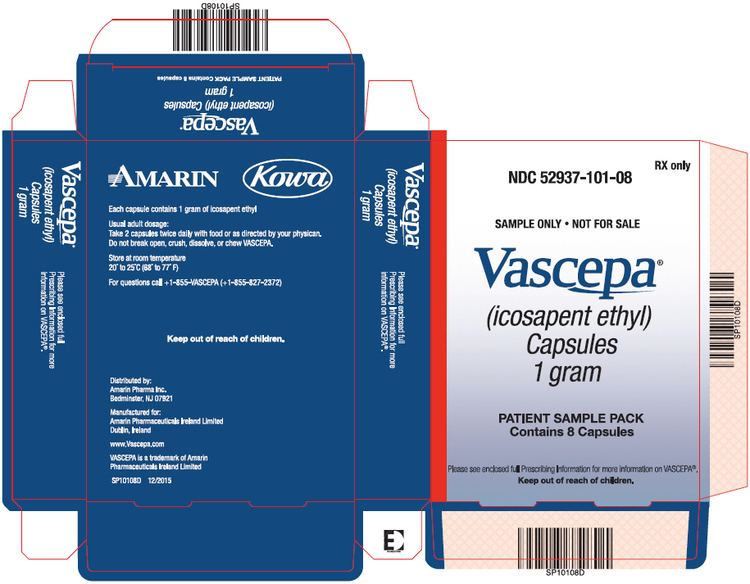 | ||
Ethyl eicosapentaenoic acid (E-EPA, icosapent ethyl) is a derivative of the omega-3 fatty acid eicosapentaenoic acid (EPA) that is used in combination with changes in diet to lower triglyceride levels in adults with severe (≥ 500 mg/dL) hypertriglyceridemia. This was the second class of fish oil-based drug to be approved for use as a drug and was approved by the FDA in 2012. These fish oil drugs are similar to fish oil dietary supplements but the ingredients are better controlled and have been tested in clinical trials.
Contents
- Medical use
- Other fish oil based drugs
- Dietary supplements
- Side effects
- Pharmacology
- Mechanism of action
- Physical and chemical properties
- History
- References
The company that developed this drug, Amarin Corporation, challenged the FDA's ability to limit its ability to market the drug for off-label use and won its case on appeal in 2012, changing the way the FDA regulates pharmaceutical marketing.
Medical use
E-EPA is used in addition to changes in diet to reduce triglyceride levels in adults with severe (≥ 500 mg/dL) hypertriglyceridemia.
Intake of large doses (2.0 to 4.0 g/day) of long-chain omega-3 fatty acids as prescription drugs or dietary supplements are generally required to achieve significant (> 15%) lowering of triglycerides, and at those doses the effects can be significant (from 20% to 35% and even up to 45% in individuals with levels greater that 500 mg/dL). It appears that both eicosapentaenoic acid (EPA) and docosahexaenoic acid (DHA) lower triglycerides, but DHA appears to raise LDL-C ("bad cholesterol") more than EPA, while DHA raises HDL-C ("good cholesterol") while EPA does not.
Other fish-oil based drugs
There are other omega-3 fish oil based drugs on the market that have similar uses and mechanisms of action.
Dietary supplements
There are many fish oil dietary supplements on the market. There appears to be little difference between in effect between dietary supplement and prescription forms of omega-3 fatty acids but EPA and DHA ethyl esters (prescription forms) work less well when taken on an empty stomach or with a low-fat meal. The ingredients of dietary supplements are not as carefully controlled as prescription products and have not been fixed and tested in clinical trials, as prescription drugs have, and the prescription forms are more concentrated, requiring fewer capsules to be taken and increasing the likelihood of compliance.
Side effects
Special caution should be taken with people who have with fish and shellfish allergies. In addition, as with other omega-3 fatty acids, taking E-EPA puts people who are on anticoagulants at risk for prolonged bleeding time. The most commonly reported side effect in clinical trials has been joint pain; some people also reported pain their mouth or throat. E-EPA has not been tested in pregnant women is rated pregnancy category C; it is excreted in breast milk and the effects on infants are not known.
Pharmacology
After ingestion, E-EPA is metabolized to EPA and EPA is absorbed in the small intestine and enters circulation; peak plasma concentration occurs about 5 hours after ingestion and the half-life is about 89 hours. EPA is metabolized mostly in the liver like other dietary fatty acids.
Mechanism of action
EPA, the active metabolite of E-EPA, like other omega-3 fatty acid based drugs, appears to reduce production of triglycerides in the liver, and to enhance clearance of triglycerides from circulating very low-density lipoprotein (VLDL) particles; the way it does that is not clear, but potential mechanisms include increased breakdown of fatty acids; inhibition of diglyceride acyltransferase which is involved in biosynthesis of triglycerides in the liver; and increased activity of lipoprotein lipase in blood.
Physical and chemical properties
E-EPA is an ethyl ester of eicosapentaenoic acid, which is an omega-3 fatty acid.
History
In July 2012, the US Food and Drug Administration approved E-EPA for severe hypertriglyceridemia as an adjunct to dietary measures; Amarin Corporation had developed the drug.
E-EPA was the second fish-oil drug to be approved, after omega-3 acid ethyl esters (GlaxoSmithKline's Lovaza which was approved in 2004) and sales were not as robust at Amarin had hoped. The labels for the two drugs were similar, but doctors prescribed Lovaza for people who had triglycerides lower than 500 mg/dL based on some clinical evidence. Amarin wanted to actively market E-EPA for that population as well which would have greatly expanded its revenue, and applied to the FDA for permission to do so in 2013, which the FDA denied. In response, in May 2015 Amarin sued the FDA for infringing its First Amendment rights, and in August 2015 a judge ruled that the FDA could not "prohibit the truthful promotion of a drug for unapproved uses because doing so would violate the protection of free speech." The ruling left open the question of what the FDA would allow Amarin to say about E-EPA, and in March 2016 the FDA and Amarin agreed that Amarin would submit specific marketing material to the FDA for the FDA to review, and if the parties disagreed on whether the material was truthful, they would seek a judge to mediate.
